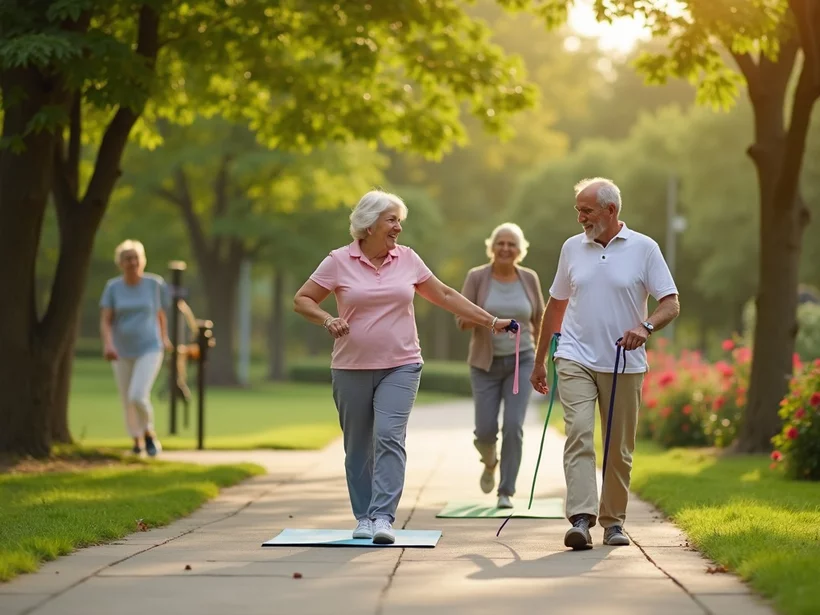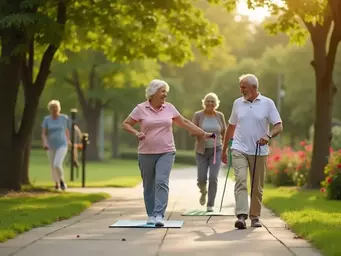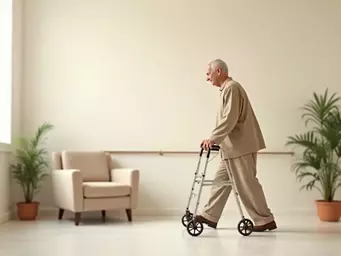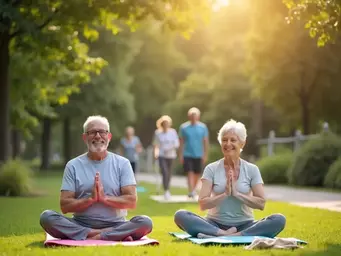Active Living: Exercises for Seniors

In a world where health is paramount, did you know that staying active is one of the most effective ways for seniors to enhance their quality of life? Regular exercise not only keeps the body fit but also uplifts one’s mental well-being. Let's explore the essential lessons on how to maintain an active lifestyle as we age.
What You Will Learn
- Regular physical activity significantly improves cardiovascular health, strength, and mental wellness in seniors.
- Staying active promotes independence, reduces feelings of depression, and enhances social engagement.
- A balanced fitness routine should include aerobic activities, strength training, balance exercises, and flexibility work.
- Technology, such as fitness trackers and workout apps, can motivate seniors to maintain their fitness goals.
- Setting achievable goals, incorporating variety, and finding a workout buddy can support sustained motivation in fitness routines.
- Engaging with community resources, like personal trainers and wellness programs, offers tailored support for seniors' fitness needs.
Benefits of Regular Exercise for Seniors
Understanding how exercise impacts seniors can help us appreciate its importance. For more insights on this topic, read about the physical activity benefits for seniors. Below is a visual representation of key benefits categorized by type of exercise:
Improved Cardiovascular Health
Regular exercise strengthens the heart and improves blood circulation, crucial for maintaining overall health.
Enhanced Strength and Balance
Strength training helps prevent falls by enhancing muscle and balance, important for seniors' safety.
Better Mental Health
Physical activity releases endorphins, improving mood and reducing feelings of depression.
Increased Independence
Staying active allows seniors to maintain their autonomy and perform daily tasks more easily.
Understanding the Importance of Staying Active for Seniors
As we age, staying active becomes more than just a hobby; it's a cornerstone of our overall health. At Cairns Active Ageing Solutions, I've seen how seniors who incorporate regular physical activity into their lives often experience improved well-being. It's not just about moving more; it’s about enhancing our quality of life and maintaining independence! Have you ever noticed how a little movement can lift your spirits? Let's dive into why exercise matters for seniors.
The Role of Exercise in Senior Wellness
Exercise plays a crucial role in senior wellness—it’s like a multivitamin for your body! Engaging in regular physical activity can help manage chronic conditions, improve mobility, and even enhance your mood. Here are some key benefits:
- Improved Cardiovascular Health: Regular exercise helps keep your heart strong and your blood flowing.
- Enhanced Strength and Balance: Activities that build muscle also help prevent falls.
- Better Mental Health: Exercise releases endorphins, often referred to as 'feel-good' hormones!
By integrating exercise into our daily routines, we can boost our health in meaningful ways. It’s all about making movement a priority! For additional resources, consider exploring ways to embrace active ageing together.
How Regular Physical Activity Enhances Quality of Life
Have you ever felt a surge of energy after a walk or a gentle workout? Regular physical activity can truly enhance our quality of life. It not only keeps our bodies healthy but also enriches our social connections and mental well-being. Research shows that seniors who stay active are often:
- More independent
- Less likely to experience depression
- More engaged in social activities
When we exercise, we open the door to numerous experiences, from participating in community classes to simply enjoying the outdoors. At Cairns Active Ageing Solutions, we encourage seniors to explore activities that bring joy and connection!
Exploring Diverse Exercise Types for Seniors
With so many options available, finding the right type of exercise can be exciting! The key is to choose activities that you enjoy and that suit your fitness level. Let's look at some popular types of exercise for seniors that promote health and happiness.
Aerobic Activities: Keeping the Heart Healthy
Aerobic activities are fantastic for heart health and can be tailored to any fitness level! These exercises increase your heart rate and improve circulation. Here are a few enjoyable options:
- Brisk Walking: A simple yet effective way to get moving.
- Swimming and Water Aerobics: Gentle on the joints, these activities provide great resistance.
- Low-Impact Aerobics: Perfect for those looking to move without too much strain.
- Zumba Gold: A fun dance-based workout designed for seniors.
These aerobic activities not only strengthen our hearts but also keep us feeling vibrant and alive. What's your favorite way to get your heart pumping?
Strength Training: Building Muscle and Bone Density
Strength training is essential for maintaining muscle mass and bone density as we age. It might sound intimidating, but there are plenty of safe and effective ways to get started. Consider these options:
- Resistance Bands: Lightweight and versatile, perfect for strength training.
- Bodyweight Exercises: Great for building strength using your own weight, no equipment needed!
- Resistance Training Machines: These offer added support and guidance during workouts.
By incorporating strength training into our routines, we can help prevent falls and maintain independence—a core mission at Cairns Active Ageing Solutions. For more information on preventing falls, check out these strategies to prevent falls in seniors.
Balance Exercises: Preventing Falls and Enhancing Stability
Balance exercises are vital for preventing falls, a significant concern for many seniors. They help enhance stability and coordination, which are essential for everyday activities. Here are a few effective balance exercises:
- Tai Chi: Gentle movements that promote coordination and balance.
- Chair Yoga: A great way to improve flexibility and stability from a seated position.
- Agility Exercises: Fun activities that enhance quickness and coordination.
Incorporating these exercises can make a big difference in how steady we feel on our feet! Have you tried any of these balance activities yet?
Flexibility Exercises: Improving Mobility
Flexibility is key for maintaining mobility and preventing injuries in older adults. Simple stretching routines can go a long way in keeping our joints healthy. Here are a few flexibility exercises to consider:
- Stretching Routines: Effective for enhancing joint health and reducing stiffness.
- Low-Impact Yoga: Integrates body and mind while improving flexibility.
Regularly practicing flexibility exercises allows us to move more freely and comfortably in our daily lives! Why not roll out a mat and try some gentle stretches today?
Quick Summary
Here's a brief recap of the key points discussed so far:
- Importance of Exercise: Regular physical activity is essential for seniors to enhance their overall health and maintain independence.
- Types of Exercises: A mix of aerobic, strength, balance, and flexibility exercises are recommended to ensure comprehensive fitness.
- Community Support: Engaging with local resources, such as fitness classes and personal trainers, can greatly enhance the fitness journey for seniors.
Addressing Common Questions About Senior Fitness
When it comes to staying active, many seniors have questions that can help guide their fitness journey. Understanding the best exercises and how to use technology effectively can significantly enhance a senior's ability to maintain an active lifestyle. Let’s dive into some common queries I often hear at Cairns Active Ageing Solutions, where my mission is to empower seniors to age gracefully through fitness.
One of the most frequently asked questions is, “What are the best exercises for seniors to stay active?” The answer typically involves a mix of aerobic, strength, balance, and flexibility exercises. These activities not only promote overall health but also help in preventing falls and improving quality of life. Let’s explore some of the top choices:
- Walking
- Swimming
- Chair yoga
- Low-impact aerobics
- Resistance training
How can technology assist in maintaining fitness for older adults?
As technology continues to evolve, it provides seniors with exciting tools to enhance their fitness journey. Fitness trackers and workout apps can offer a great support system, making it easier to stay motivated. I always encourage the seniors I work with to explore these options, as they can provide accountability and guidance in their routines.
Fitness trackers are fantastic for monitoring progress effectively. They can track steps, heart rate, and even sleep patterns! This data can be immensely helpful for seniors to understand their physical activity levels better. Now, let’s look at some specific technology tools that can aid in maintaining fitness:
- Fitness Trackers: Devices like Fitbit or Apple Watch that monitor activity levels.
- Senior Workout Apps: Applications like SilverSneakers or MyFitnessPal that offer tailored workouts and nutrition tips.
Encouraging a Lifelong Commitment to Fitness
Staying active is not just a short-term goal; it’s a lifelong commitment. To help seniors stay motivated and consistent in their exercise routines, I often share practical tips that can make a significant difference. By nurturing this mindset, we can encourage an active lifestyle that feels rewarding and enjoyable!
Here are some effective tips I recommend:
- Set achievable fitness goals.
- Incorporate variety into workouts to keep them interesting.
- Find a workout buddy for accountability.
- Celebrate milestones, no matter how small!
Connecting with Community Resources: Classes and Support Systems
At Cairns Active Ageing Solutions, I believe in the power of community. Connecting with local resources can greatly enrich a senior's fitness experience. There are many options available, from fitness classes to wellness programs that cater specifically to older adults.
For those looking for personalized guidance, consider engaging with a personal trainer who specializes in senior fitness. They can offer tailored support that aligns with individual needs and goals. Here are some community resources you might find helpful:
- Personal Trainers for Seniors: Professional trainers who can customize workouts for safety and effectiveness.
- Senior Wellness Programs: Comprehensive approaches that integrate exercise, nutrition, and social activities.
Frequently Asked Questions About Senior Fitness
Here are some common questions about senior fitness, based on the topics discussed in this article:
- Q: Why is regular exercise important for seniors?
- A: Regular exercise is crucial for seniors to enhance their overall health, improve cardiovascular function, strengthen muscles and bones, boost mental well-being, and maintain independence. It also helps manage chronic conditions and reduces the risk of falls.
- Q: What types of exercises are recommended for seniors?
- A: A balanced fitness routine for seniors should include a mix of aerobic activities (like walking, swimming, Zumba Gold), strength training (using resistance bands, bodyweight, or machines), balance exercises (such as Tai Chi, chair yoga), and flexibility exercises (stretching, low-impact yoga).
- Q: How can technology help seniors stay active?
- A: Technology can be a great motivator and support system. Fitness trackers monitor activity levels, heart rate, and sleep, providing valuable data. Senior workout apps offer tailored routines and nutrition tips, making it easier to stay consistent and accountable.
- Q: How can seniors maintain motivation for their fitness routines?
- A: To maintain motivation, seniors should set achievable goals, incorporate variety into their workouts, find a workout buddy for accountability, and celebrate small milestones. Engaging with community resources can also provide support and new opportunities.
- Q: Where can seniors find support for their fitness journey?
- A: Seniors can connect with local community resources such as fitness classes, wellness programs designed for older adults, and personal trainers specializing in senior fitness. These resources offer tailored support and guidance to meet individual needs and goals.
Final Thoughts on Maintaining Active Lifestyles for Seniors
As we wrap up, let’s summarize some key takeaways for safe senior exercise. Staying active is crucial for maintaining independence and enhancing quality of life. By incorporating a variety of exercises, utilizing technology, and connecting with community resources, seniors can build an engaging and sustainable fitness routine. For more tips on keeping your home safe as you age, explore ensuring home safety for seniors.
If you’re considering starting or continuing your active journey, I encourage you to take that leap! Remember, every step counts towards a healthier, happier life. Whether it’s through a brisk walk or a fun dance class, let’s embrace the joy of movement together!
Recap of Key Points
Here is a quick recap of the important points discussed in the article:
- Regular Exercise Benefits: Improves cardiovascular health, enhances strength and balance, and boosts mental health.
- Quality of Life Enhancement: Staying active leads to greater independence, reduced depression, and increased social engagement.
- Diverse Exercise Types: Incorporate aerobic, strength, balance, and flexibility exercises tailored to individual fitness levels.
- Utilizing Technology: Fitness trackers and workout apps can aid in motivation and progress monitoring for seniors.
- Community Resources: Engage with local fitness classes, personal trainers, and wellness programs designed for seniors.
- Lifelong Commitment: Set achievable goals, mix up routines, and celebrate milestones to maintain an active lifestyle.









